ABOUT CAPPADOCIA
How to Get There?
Congress venue Perissia Hotel Cappadocia is located in Ürgüp district of Nevşehir. Perissia hotel is accessible with a 49 km ride from Kapadokya Airport (NAV). The second closest airport to Perissia Hotel is Kayseri Airport (ASR) which is 75 km away. The recommended one in distance aspect is Kapadokya Airport.
Please contact Organizing Secretariat at evrs2023@valor.com.tr for transportation from Kapadokya Airport to Perissia Hotel.
Cappadocia
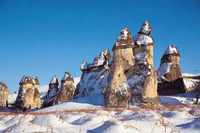 Cappadocian region is the place where the nature and history come together with most beautiful scene in the world. While geographic events are forming Peribacaları (fairy chimneys), during the historical period, humans had carried the signs of thousand years old civilizations with carving houses and churches within these earth pillars and decorating them with frisks.
Cappadocian region is the place where the nature and history come together with most beautiful scene in the world. While geographic events are forming Peribacaları (fairy chimneys), during the historical period, humans had carried the signs of thousand years old civilizations with carving houses and churches within these earth pillars and decorating them with frisks.
During the Roman Emperor, Augustus period, territories of Cappadocian Region as a wide region lying till to the Toros Mountains at south, Aksaray at west, Malatya at east and Eastern Black Sea shores at north within the 17 volume book named ‘Geographika’ of Strabon, one of the Antic Period writers. Today’s Cappadocian Region is the area covered by Nevşehir, Aksaray, Niğde, Kayseri, and Kırşehir cities. More limited area, rocky Cappadocian Region is composed of Üçhisar, Göreme, Avanos, Ürgüp, Derinkuyu, Kaymaklı, Ihlara and environment.
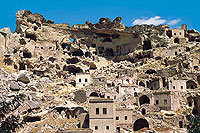
Traditional Cappadocian houses and dovecotes carved into stones are showing the uniqueness of the region. These houses are constructed on the feet of the mountain via rocks or cut stones. Rock, which is the only construction material of the region, as it is very soft after quarry due to the structure of the region, can be easily processed but after contact with air it hardens and turns into a very strong construction material. Due to being plentiful and easy to process of the used material, regional unique masonry is developed and turned into an architectural tradition. Materials of neither courtyard nor house doors is wood. Upper parts of the doors built with arches are decorated with stylized ivy or rosette motifs.
 Dovecotes within the region are small structures constructed within 18th century and end of 19th century. Some of the dovecotes, which are important for showing Islamic picture art are constructed as monastery or church. Surfaces of dovecotes are decorated with rich inscriptions and adornments by regional artists.
Dovecotes within the region are small structures constructed within 18th century and end of 19th century. Some of the dovecotes, which are important for showing Islamic picture art are constructed as monastery or church. Surfaces of dovecotes are decorated with rich inscriptions and adornments by regional artists.
Ürgüp
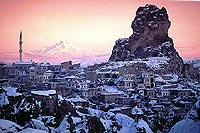 Ürgüp, 20 km east of Nevsehir, is one of the most important centres of the Cappadocia region. Like Goreme, it had numerous names in the course of its history, and its cave dwellings scattered around the village make it a very tourist-friendly destination. It has many hotels and guest-houses, good entertainment, old Greek houses from before the population exchange of 1923, and an atmosphere which has remained attached to its tradition despite a modernising tourist industry. It is a good base to explore the nearby Goreme Valley.
Ürgüp, 20 km east of Nevsehir, is one of the most important centres of the Cappadocia region. Like Goreme, it had numerous names in the course of its history, and its cave dwellings scattered around the village make it a very tourist-friendly destination. It has many hotels and guest-houses, good entertainment, old Greek houses from before the population exchange of 1923, and an atmosphere which has remained attached to its tradition despite a modernising tourist industry. It is a good base to explore the nearby Goreme Valley.
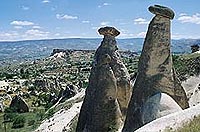
Climate
From season to season, the climate is quite extreme. Summers are hot and dry, with warm nights. Winters are cold and it can even snow, while spring and autumn are mild.
History
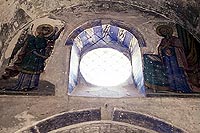 With a geological structure of volcanic formations, Urgup was established within the region which had been shaped into fantastic forms known as ‘Fairy Chimneys’, through erosions of water and wind. The were formed as floodwater poured down the sides of the valleys, combined with strong winds which tore away the softer volcanic rocks, resulting in this unique landscape. It is an important centre in Cappadocia, and has been known by many names: Osian (Assiana), Hagios Prokopios (Byzantine), Bashisar (Seljuk), Burgat Kaalesi (Ottoman) and finally Urgup, from shortly after the founding of the Turkish Republic.
With a geological structure of volcanic formations, Urgup was established within the region which had been shaped into fantastic forms known as ‘Fairy Chimneys’, through erosions of water and wind. The were formed as floodwater poured down the sides of the valleys, combined with strong winds which tore away the softer volcanic rocks, resulting in this unique landscape. It is an important centre in Cappadocia, and has been known by many names: Osian (Assiana), Hagios Prokopios (Byzantine), Bashisar (Seljuk), Burgat Kaalesi (Ottoman) and finally Urgup, from shortly after the founding of the Turkish Republic.
Where to Visit
Pembe Valley
The most stunning examples of the local landscape and the Fairy Chimneys can be seen along the route to Avanos. Many of these rock formations resemble animals, and the shapes of camels and rabbits can be seen.
Kızılçukur
As a centre of grape and wine production, Kizilcukur, a couple of kilometres northwest of Urgup, contains churches cut into the strange rock formations and decorated with grape figures. The rocks are decorated in different colours, making it a spectacular sight at sunset.
Mustafapaşa
Located 5km from Urgup, the small village of Mustafapasa has old stone houses with attractive carved facades dating back to the end of the 19th century, and a cluster of small churches. Once known as Sinasos when it was a thriving Greek community before World War I, it makes an interesting trip from Urgup although is not easily accessible by public transport. Places of interest include a 19th century medrese, the Ayios Vasilios Church, and the Church of Sts Constantine and Helena. There are several small guest-houses and restaurants.
Sarıhan
Sarihan (Yellow Caravanserai), around 10km north of Urgup, was constructed by Seljuk Sultan Alaattin Keykubat in 1217. It has a huge courtyard with elaborate gateway, and was used for the loading of animals and a place for travellers break their journey. It is also a great example of Seljuk-Turkish architecture. The road was re-laid and the building restored in the late 1980s, and is now functioning as a museum and cultural centre with performances of dervish dancing in the summer. There is rarely public transport to Sarihan.
Halacdere
Engraved into the tuffs, these basilica-type churches were thought to have been used as hospital buildings by the Christians, and are now almost destroyed. Similar ones can be seen in Ortahisar, like St Peter and St Paul Churches, and the one near the Meskendir River.
Fıratkan
Firatkan is a small complex of churches, located on the road to the Goreme Open Air Museum. They have two storeys, consisting of a dormitory, dining hall, kitchen and storerooms, and the storeys are connected to each other through tunnels.
Ortahisar
This village, 3 km southeast of the Goreme Valley, is most famous for its 50m high rock-castle, which is visible from the main road. It is possible to climb the rock, which offers stunning views of the surrounding area. This attractive farming village also has examples of the monastery lifestyle, and is a strong cultural and commercial centre. Other places of interest in this area include Harim Church, Sanca Church and Cambazli Church.
Damsa Dam
It is constructed on the Damsa River, the dam is 17 km from Urgup and used mainly for irrigation. It is now an attractive area for walks and picnics, on the shore of the Damsa Lake, surrounded by pine forests and offering good shade in the summer. It is a convenient place to stop en route to Mustafapasa, Taskinpasa and Soganli.
Museums
Ürgüp Museum
The museum is opened in 1971, where Prehistorical, Ancient Bronze Age, Hittite, Frig, Persia, Hellenistic, Roman, Byzantium and Ottoman period pieces of arts besides Ürgüp and environs acquired fossil samples are in the museum. There is also an ethnographic section for regional clothes, furniture and guns within the museum.
Ruins of Ürgüp Museum are Mustafapaşa (Sinasos) Aios Vasilios Church, Monastery Valley Churches, Yeşilöz (Saint Theodor) Church and Pancarlık Church.
Relıgıous Monuments
Saint Theodore (Tagar) Church
Around 15 km southeast of Urgup, the village of Yesiloz contains the famous T-shaped St Thoedore’s Church. It is possible to access the gallery on the upper floor by a ladder, making it unique in Cappadocia. The church has been decorated by three artists, whose pictures are generally well preserved. Scenes depicted include the prophets, the disciples, Christ on the crucifix and the angels Gabriel and Michael.
Pancarlık Church
South of Ortahisar in the Pancarlik Valley, this church dates back to the first half of the 11th century. Its intricate religious paintings are predominantly green, and have generally been well preserved. They depict a vast range of biblical scenes, including Joseph’s second dream, the escape to Egypt, the miracle of the water into wine, the loaves and fishes, the cure of a leper, Christ on the crucifix and later his resurrection.
Scenes
Appearances of the prophets, herald, visit, evidence of virginity, voyage to Beytüllahim, birth, worship of three astrologer, second dream of Joseph, escape to Egypt, massacre of innocent children, introduction of Jesus Christ to temple, follow up of Elizabeth, appointment of Baptist Yahya, baptism, test of Jesus Christ, Kana marriage, wine miracle, fish and bread augmentation, appointment of disciples for sake of God, cure of devil crooked man, cure of leper man, cure of disabled woman, cure of daughter of Jairus, fish augmentation miracle, Jesus Christ and woman from Samarra, metamorphism, Jesus Christ on the way to Golgotha, Jesus on crucifix, Landing of Jesus Christ to inferno, rise of Jesus Christ to the sky, angel Gabriel and Michael and saint pictures in medallions.
Ala Church and Kepez Churches
These are considered important churches in the region, located on the road of Pancarkil. They have plain red decorations, and frescoes.
Balkan Churches
These form a small cluster, some 2 km from Ortahisar, and date back to the Ikolonazma period.
Taşkınpaşa Mosque
Taskinpasa mosque is in the centre of the village of Damsa, 20 km south of Urgup, dates back to the Karamanlilar period. Its balcony is made of walnut ornamental inlaying, which is the only remaining one of its kind. The Taskinpasa Tomb, belonging to Hizir Reis, is opposite the mosque and belongs to the same period.
Castles
Kadı Castle
This rock-castle was a place of refuge for women and children during times of danger. A tunnel opened to the Damsa River, constructed for the purpose. Most of the building has since collapsed mainly due to erosion, but the undamaged section is open to visitors.
Tombs
Temenni (Mausoleum )
This monumental Selcuk tomb, constructed by Vecihi Pasa and dedicated to Kilicarslan IV, dates back to 1288. Perched on Kadi Kalesi, the most peculiar feature of the tomb is the 700m tunnel, of which the original purpose is unclear. It has an Ottoman library, one of the oldest in Anatolia, with photographs of pre-1923 Urgup. Visitors are allowed to walk through the corridor that leads to the point of a wonderful view of the surrounding countryside.
Opening hours: 08:30 – 18:00, daily.
Altıkapı
Literally translating as Six Gates Tomb, this monument in the north of the city centre was constructed by a commander from the 12th of 13th century Selcuk period, and dedicated to his wife and children.